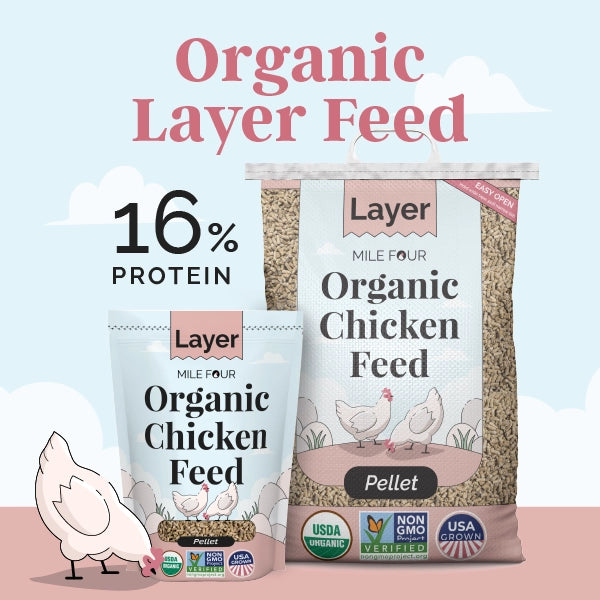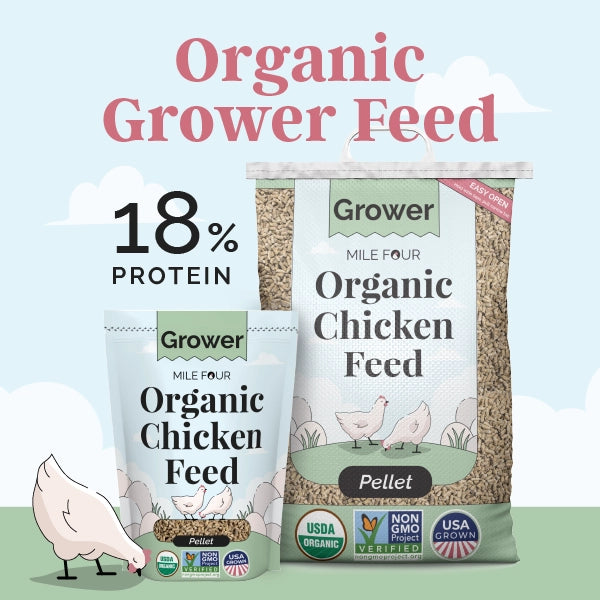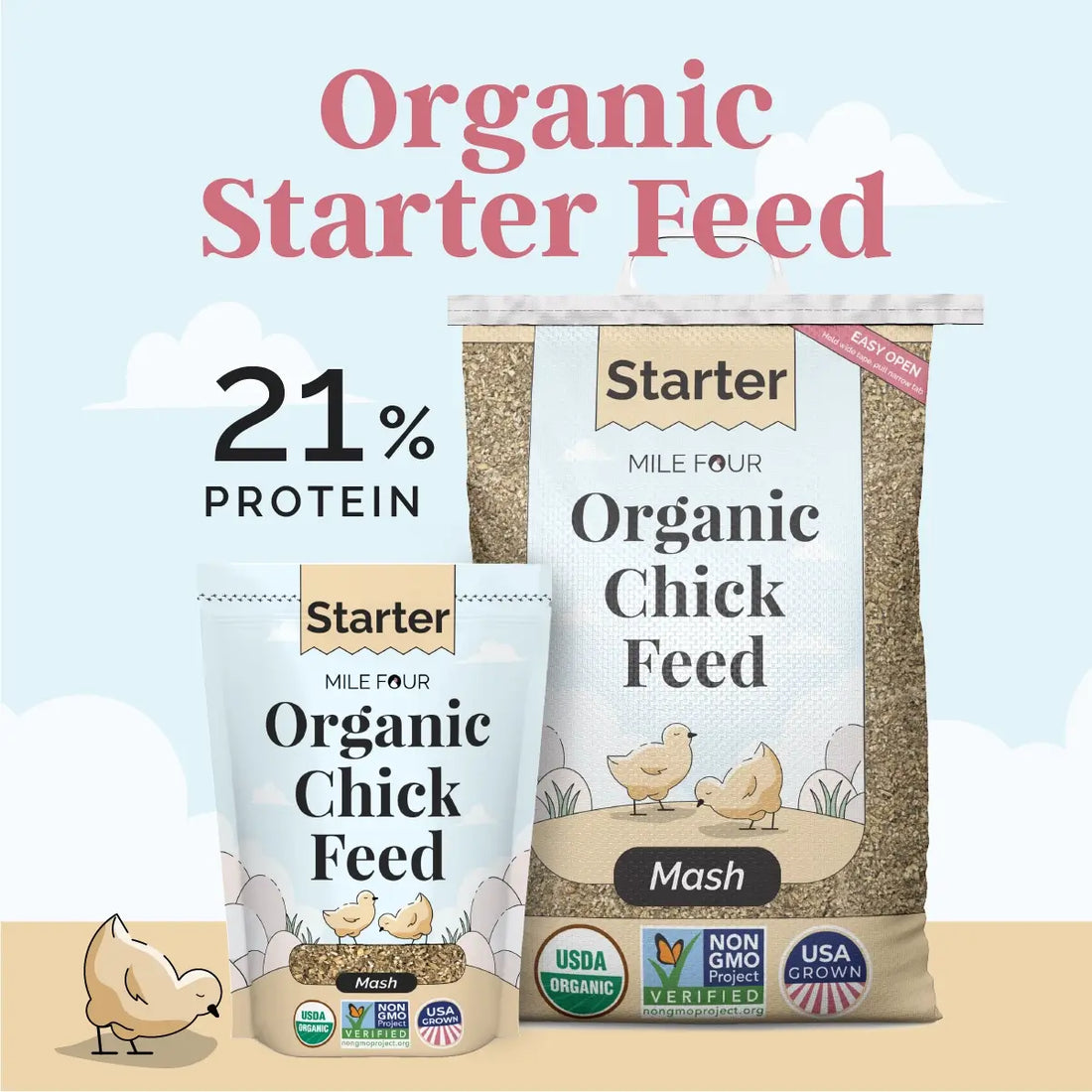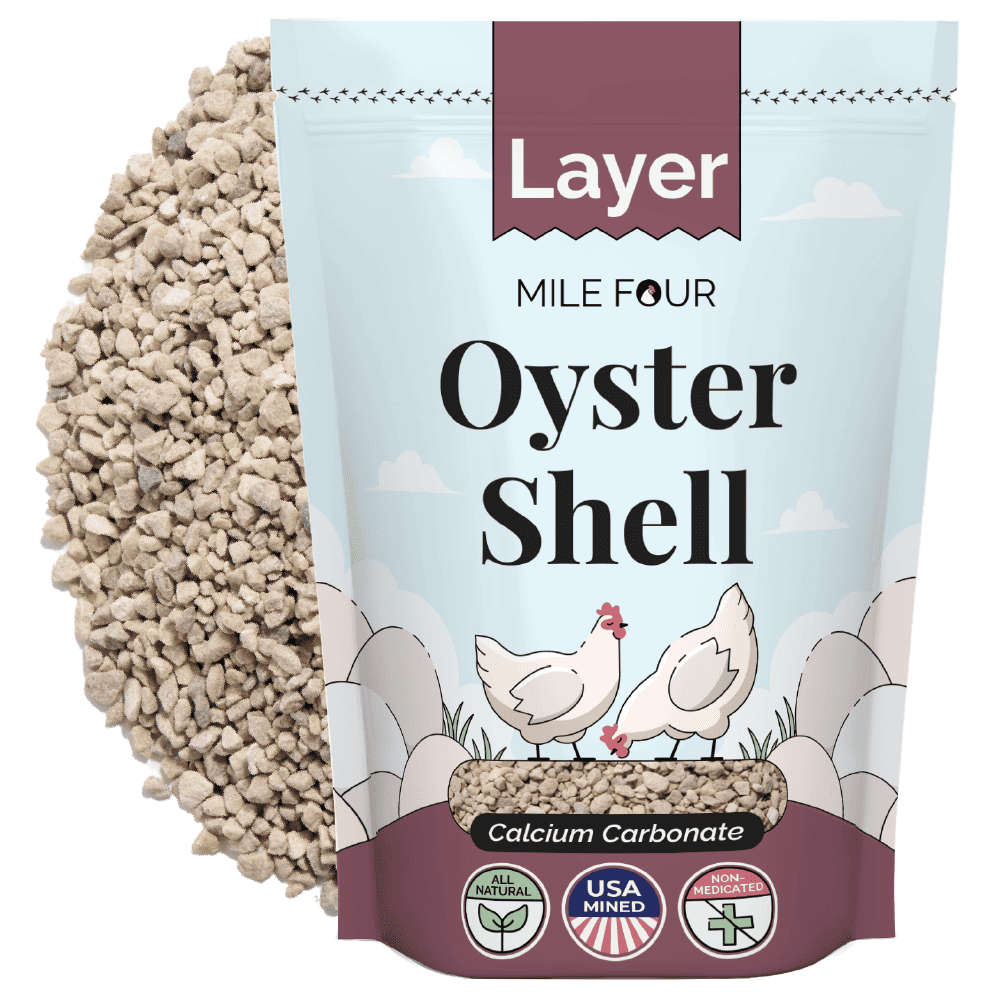Chicken Feed!
The most important thing you definitely don’t want to skimp on in your backyard farm.
Chickens need different types of feed at different ages in their lives. Chicks will eat more protein than laying hens, and laying hens will need more calcium than chicks!
It’s something that a beginner will need to pay attention to, especially if your plan is to have different aged chickens in your flock.
In this guide, we’ll go through the different types of chicken feed as well as recommendations for each.
Below are charts with all available 16% Layer Chicken Feed on the market so you can compare apples-to-apples when making your decision.
Full Disclosure: We are an organic chicken feed producer and, while we think our feed is the best in the world, just ask us, we created this guide to be as objective as possible.
Shameless sales pitch: Try our freshly milled, organic chicken feed risk free. If your chickens don't love their 1st bag, it's on us.
Quick Jump
Chicken Feed Variations
| Certified Organic Chicken Feed | Mile Four | Scratch & Peck |
Joenks Farm | Coyote Creek | Manna Pro |
| Feed Cost per lb* | $1.42 | $1.51 | $2.59 | $1.75 | $1.96 |
| Review Score | 4.9 | 4.7 | 4.8 | 4.5 | 3.6 |
| Quality | |||||
| Certified Organic | ✔ | ✔ | ✔ | ✔ | ✔ |
| Non-GMO | ✔ | ✔ | X | X | ✔ |
| 100% U.S. Grains | ✔ | ✔ | N/A | ✔ | N/A |
| Corn Free | ✔ | ✔ | X | X | X |
| Soy Free | ✔ | ✔ | ✔ | X | ✔ |
| Feed Mix | |||||
| Whole Grain | ✔ | ✔ | ✔ | X | X |
| Mash | ✔ | X | X | X | X |
| Pellets | ✔ | X | X | ✔ | ✔ |
| Crumble | X | X | X | X | X |
| Cost Details | |||||
| Feed Cost per lb* | $1.42 | $1.51 | $2.59 | $1.75 | $1.96 |
| Cost | $37.88 | $37.99 | $25.99 | $35 | $59 |
| Free Shipping | ✔ | ✔ | N/A | X | N/A |
| Shipping Cost (per bag) | $0 | $0 | N/A | N/A | N/A |
| Bag Size (lb.) | 23 lb. | 25 lb. | 10 lb. | 20 lb. | 30 lb. |
| Layer 16% Protein | ✔ | ✔ | ✔ | ✔ | ✔ |
| Subscription Options | |||||
| Subscription Available | ✔ | ✔ | X | X | X |
| Subscription Savings | 5% | 5% | N/A | N/A | N/A |
| Subscription Options | Weekly/Monthly/Quarterly | Monthly | N/A | N/A | N/A |
| Where to Buy | |||||
| Website | Yes | Yes | X | X | X |
| Amazon | Yes | Yes | Yes | Yes | Yes |
| Chewy | Yes | Yes | X | X | X |
| Retail | Yes | ✔ | X | ✔ | ✔ |
|
Not Certified Organic Feed Pellet Feed |
Dumor | Kalmbach Feeds | Purina | Kaytee | Browns |
| Feed Cost per lb* | $3.09 | $0.56 | $0.64 | $1.39 | $1.73 |
| Review Score | 4.7 | 4.2 | 4.8 | 4.3 | 4.1 |
| Quality | |||||
| Certified Organic | X | X | X | X | X |
| Non-GMO | X | X | X | X | X |
| 100% U.S. Grains | N/A | ✔ | N/A | ✔ | N/A |
| Corn Free | N/A | X | N/A | X | X |
| Soy Meal Free | N/A | X | N/A | ✔ | X |
| Feed Mix | |||||
| Whole Grain | X | X | X | X | X |
| Mash | X | X | X | X | X |
| Pellets | ✔ | ✔ | ✔ | ✔ | ✔ |
| Crumble | ✔ | ✔ | X | X | N/A |
| Cost Details | |||||
| Feed Cost per lb* | $3.09 | $0.56 | $0.64 | $1.39 | $1.73 |
| Cost | $14.99 | $27.99 | $16 | $26 | $34.63 |
| Free Shipping | X | N/A | N/A | ✔ | ✔ |
| Shipping Cost (per bag) | $15.99 | N/A | N/A | N/A | N/A |
| Bag Size (lb.) | 10 lb. | 50 lb. | 25 lb. | 25 lb. | 20 lb. |
| Layer 16% Protein | ✔ | ✔ | ✔ | ✔ | ✔ |
| Subscription Options | |||||
| Subscription Available | X | X | X | X | X |
| Subscription Savings | N/A | N/A | N/A | N/A | N/A |
| Subscription Options | N/A | N/A | N/A | N/A | N/A |
| Where to Buy | |||||
| Website | X | X | X | X | X |
| Amazon | X | Yes | Yes | Yes | Yes |
| Chewy | X | Yes | X | X | X |
| Retail | X | ✔ | X | X | ✔ |
|
Not Certified Organic Mash & Pellet/Grain Mix |
Small Pet Select | Grubbly Farms | Healthy Harvest | Prairie's Choice | Blue Seal Home Fresh |
| Feed Cost per lb* | $1.44 | $1.43 | $1.59 | $1.40 | $0.66 |
| Review Score | 4.6 | 4.8 | 3.6 | 4.4 | 4.3 |
| Quality | |||||
| Certified Organic | X | X | X | X | X |
| Non-GMO | ✔ | X | ✔ | ✔ | X |
| 100% U.S. Grains | N/A | ✔ | N/A | ✔ | ✔ |
| Corn Free | ✔ | X | X | X | N/A |
| Soy Meal Free | ✔ | ✔ | X | X | N/A |
| Feed Mix | |||||
| Whole Grain | Mixed w/ Pellets | Mixed w/ Pellets | X | X | X |
| Mash | X | X | X | X | X |
| Pellets | ✔ | ✔ | X | X | X |
| Crumble | X | X | ✔ | ✔ | ✔ |
| Cost Details | |||||
| Feed Cost per lb* | $1.44 | $1.43 | $1.59 | $1.40 | $0.66 |
| Cost | $35.99 | $42.99 | $21.99 | $35 | $16.99 |
| Free Shipping | ✔ | ✔ | X | N/A | X |
| Shipping Cost (per bag) | $0 | $0 | $10 | N/A | $15.99 |
| Bag Size (lb.) | 25 lb. | 30 lb. | 20 lb. | 25 lb. | 50 lb. |
| Layer 16% Protein | ✔ | ✔ | X** | ✔ | ✔ |
| Subscription Options | |||||
| Subscription Available | ✔ | ✔ | X | X | X |
| Subscription Savings | 5% | 5% | N/A | N/A | N/A |
| Subscription Options | Monthly/Quarterly | Monthly | N/A | N/A | N/A |
| Where to Buy | |||||
| Website | Yes | Yes | Yes | X | X |
| Amazon | Yes | Yes | Yes | Yes | X |
| Chewy | X | X | Yes | X | X |
| Retail | ✔ | X | ✔ | X | ✔ |
*includes shipping
**17% layer
Last updated 9/2/21 (If you have new information about the chart, please email and we'll update!)
What to Feed Chickens
Nutritional specifics aren’t something you need to stay too on top of if you’re choosing the right feed already.
In your research for the right feed, however, you’ll want to make sure that what you’re giving your ladies is certified organic and non-GMO.
This is because your chickens simply don’t need to feed on things that have been modified and altered in a factory.
You'll also want to pay attention to corn and soy. These are two added extras in certain feeds that don't have any real nutritional benefit for your chickens, and can also cause issues for humans with allergies.
Organic Chicken Feed
Organic chicken feed is generally more expensive than a conventional feed you’ll find at any pet store because of the labor involved in the production and the farming of organic ingredients. However, the pros of feeding chickens organic far outweigh the cons.
Organic and non-GMO feed is free of any pesticides, hormones and more substances that chickens simply don’t need in their diet.
It must also be considered that we do not know the long-term health risks of using GMO’s in chicken feed.
You’re most likely eating your chickens’ eggs for breakfast, so using an organic, non-GMO feed will not only keep your chickens happy and healthy, you and your family will benefit too!
Feed that is corn and soy free will also help humans with any allergies, as these ingredients can potentially transfer to the eggs you'll be eating.
Because organic feed is generally more expensive, some backyard farmers like to ferment their feed so it lasts longer. There are also many nutritional benefits to fermenting, so if you have the time, we’d absolutely recommend it!
In the fermenting process, bacteria break down the feed and give your chickens more vitamins and minerals which can improve digestion, and even strengthen the immune system of a chicken.
Below we’ve provided a handy graphic on how to ferment your own chicken feed. It’s super easy!
Download a FREE 'How to Ferment Chicken Feed' PDF.

You’ll want to keep your chickens as healthy as possible, as there are a lot of infections and diseases that they are susceptible to. For more information, check out our health chapter in the Ultimate Beginner’s Guide to Backyard Chickens!
Chick Starter Feed
As the header suggests, you’ll be using Starter Feed for your chicks. All the way from hatching up to about six weeks of age.
Starter feed has a higher protein content than other variations of feed and it gives the chicks the necessary nutrients they need in this period of quick growth.
The best way to feed your chicks is inside a brooder at first with a feeder as opposed to free feeding. Be sure that chicks get plenty of water initially before introducing the feed. It’ll help them with digestion.
If you fear one of your chicks isn’t eating or getting the hang of the feeder, you can gently hold them close by the feeder until it starts to eat. This way, next time it gets hungry, it’ll know where to go and what to do.
Once a chick gets to six weeks of age you’ll need to transition them to a grower feed (also known as “finisher” in some circles).
This is because the high protein content in starter feed will become an issue for a chicken's liver if they keep eating it.
Grower Feed for Chickens
You’ll start to feed grower feed (also known as “finisher”) to pullets from six weeks of age. Pullets are chickens that are less than a year old who haven’t started laying eggs yet.
During this time they will need to eat more protein than egg-laying hens, but less protein than baby chicks.
Feeding a pullet hen a high protein diet can lead to Fatty Liver Hemorrhagic Syndrome. This is where large amounts of fat are deposited in a hens liver.
A lot of the time the disease doesn’t have any symptoms before death, so ensuring you switch to a grower feed at six weeks is vital.
Grower chicken feed usually has 18% protein and has less calcium than the layer feed you’ll switch to when your ladies reach 20(ish) weeks old and/or lay their first egg.
You won’t want to transition your feed to layer until your hen lays its first egg. That’s why we say 20(ish) weeks instead of being more definitive.
Some hens won’t lay until 24 weeks, some even longer depending on the weather. Colder weather means fewer eggs in most cases.
Chicken Layer Feed
As soon as you collect that first egg from your hen you should transition her to a 16% protein layer feed.
Thankfully, this is the last time you’ll need to change feed for your hens, but you will want to have some supplements available for egg production.
Oyster Shell is the best of these supplements, as it gives your laying hens extra calcium that they need for stronger eggshells.
We have more information on Oyster Shell in our Beginner’s Guide to Raising Backyard Chickens.
16% protein layer feed is considered best for your laying birds, but there is generally an 18% variation that you can get for cold winters.
Most of the time they won’t need the extra protein, but if you’re worried about your chickens staying warm, it’s a good option.
Can Ducks Eat Chicken Feed?
Simply put, yes! Ducks can eat chicken feed throughout their lives, but you’ll want to supplement niacin into their diet because they won’t get enough in a regular layer feed.
The easiest way to do this is with peas from the grocery store. You can scatter them on the floor if you’re free-feeding, or as a treat to keep their niacin levels where they need to be.
Some chicken feed will have niacin supplement already added, so you’ll want to check the ingredients before you buy extra niacin for ducks.
Best Chicken Feed
We have tried to compile all the information in the chart above that should be relevant to choosing the right feed for your flock, but if you think something is missing from the chart, let us know and we’ll add it in! Leave a comment below.




![Winter Chicken Care | Ultimate Guide [2025]](http://milefour.com/cdn/shop/articles/Mile_Four-Content-15_e1067340-1a72-4632-83f5-c66d9a2158d9.png?v=1765974101&width=1500)





2 comments
Healthy for your chicken, strictly non-GMO, and free from corn which is what I like the most.
Organic to the core they don’t even use any corn or soy ingredients.